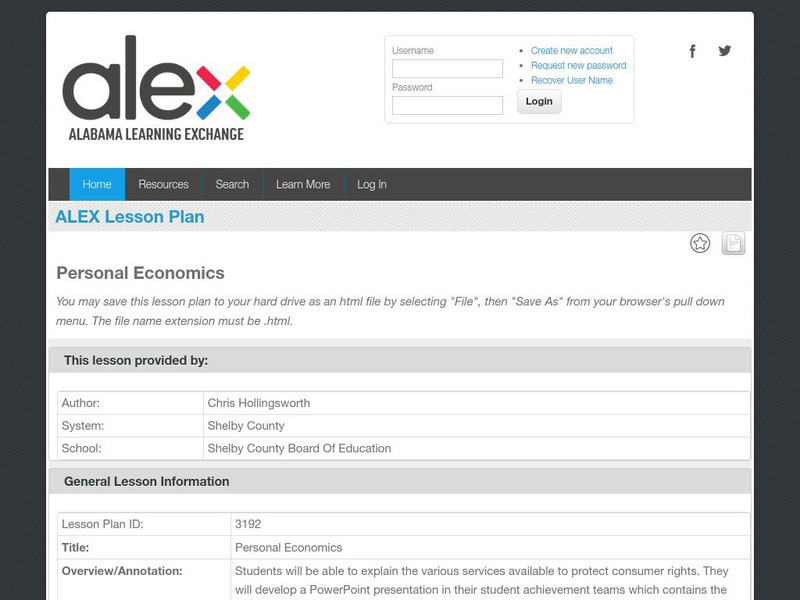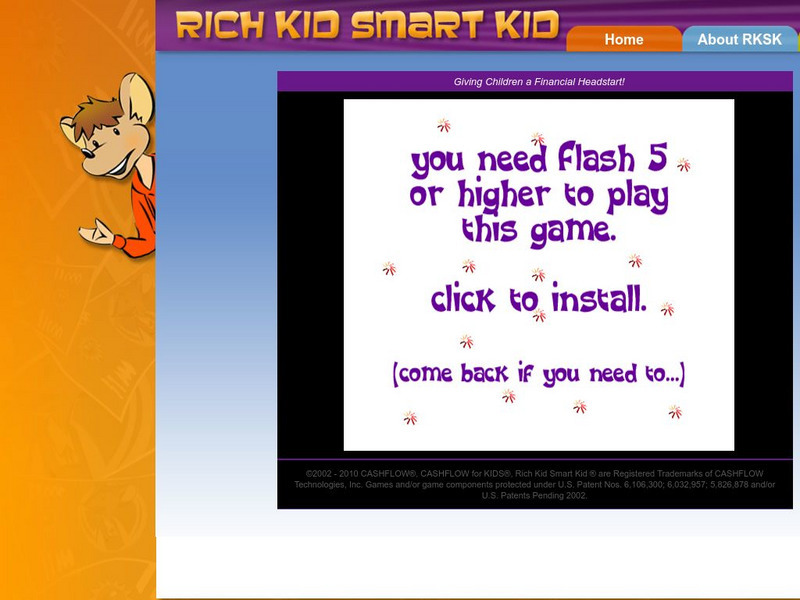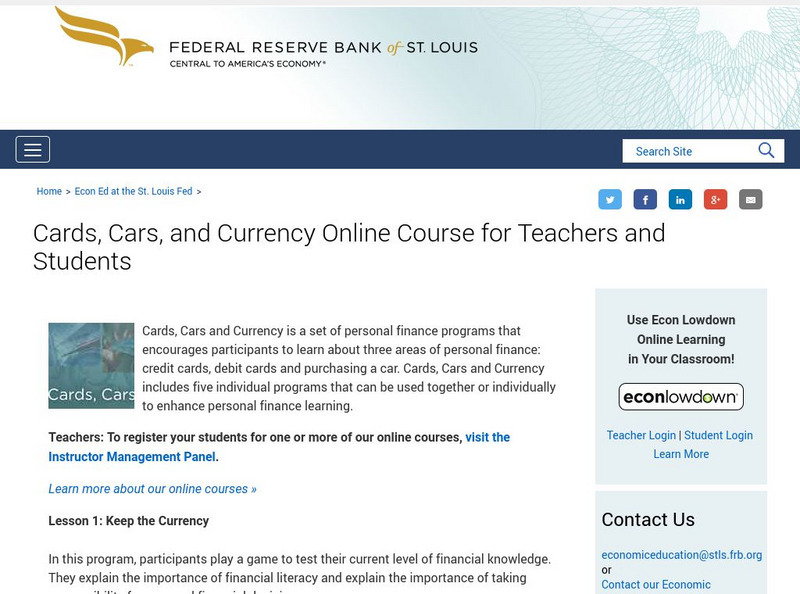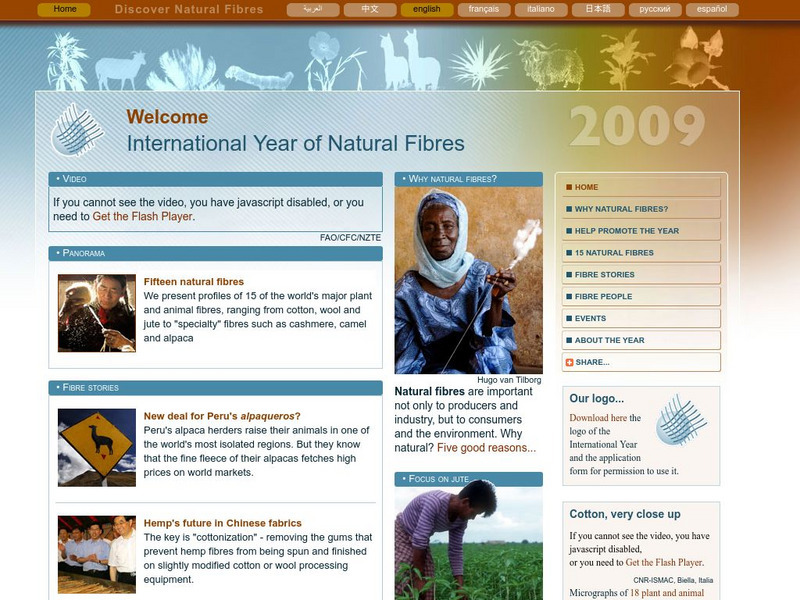Independence Hall Association
U.s. History: A Consumer Economy
The booming economy of the 1920s introduced new products and ways of paying for those products. Read about the increase in the kinds of household appliances, places to buy the appliances, and the financing of all those new consumer goods.
Other
Streetlaw: Consumer and Housing Law
Read about contracts, warranties, credit, deceptive sales practices, cars, and housing--important topics for consumers. This website provides introductory material to each of the above topics and links for further information and research.
PBS
Wnet: Thirteen: What's Up in Finance?: It Costs What?
An interactive game helps students learn the extra costs involved with using credit cards. Find out how a group of teens can purchase the exact same products in the same store yet pay different amounts for them.
Cato Institute
Atm Surcharges and the Expansion of Consumer Choice
This site is an essay that by advocates of ATM surcharges.
Council for Economic Education
Econ Ed Link: Bringing the Market to the Farm
This printable lesson discusses producers and consumers from an agricultural perspective. It focuses on choices that the consumer has with regard to purchasing agricultural goods (e.g. fruits and vegetables). As an example, it uses...
Council for Economic Education
Econ Ed Link: Satisfaction Please! (Part 3)
Even the savviest consumer has a problem with a good or service on occasion. It is a consumer's right to complain when there is a genuine problem. In some situations, it is also a consumer's responsibility. A problem can't be fixed if no...
Council for Economic Education
Econ Ed Link: Satisfaction Please! (Part 2)
Even the savviest consumer has a problem with a good or service on occasion. It is a consumer's right to complain when there is a genuine problem. In some situations, it is also a consumer's responsibility. A problem can't be fixed if no...
Council for Economic Education
Econ Ed Link: Satisfaction Please! (Part I)
Even the savviest consumer has a problem with a good or service on occasion. It is a consumer's right to complain when there is a genuine problem. In some situations, it is also a consumer's responsibility. A problem can't be fixed if no...
Council for Economic Education
Econ Ed Link: Did You Get the Message?
Advertising is the primary tool used by businesses to tell consumers about the goods and services they sell in the marketplace. Businesses also use advertising to try to convince consumers to buy what they are selling. Advertisements do...
Alabama Learning Exchange
Alex: Personal Economics
Students will be able to explain the various services available to protect consumer rights. They will develop a PowerPoint presentation in their student achievement teams which contains the required information along with a question...
Other
Rich Kid Smart Kid: Reno's Dilemma
Interactive games for students of all grade levels, K-12, teaches basic concepts of finance, in particular, good debt and bad debt.
Other
Wisconsin Educational Communications Board: Financial Literacy: Teach It!
Students at all grade levels learn about basic finance skills and explore ways to make informed decisions about their financial future.
Khan Academy
Khan Academy: Lesson Overview: Consumer and Producer Surplus
This lesson introduced the basics of a branch of economics known as welfare economics, which is interested in how the allocation of resources affects well-being. The most important concepts used in welfare analysis are total surplus and...
Federal Trade Commission
Federal Trade Commission: Consumer: Buying a Used Car
You can save a lot of money by buying a used car instead of a new car. Article provides tips for buying a used car. Also, learn about warranties and how to pay for it.
University of Regina (Canada)
University of Regina: Math Central: Stewart Resources Centre: Consumer Wise [Pdf]
A tenth-grade math unit, developed in 1993 by a Saskatchewan teacher, on budgeting.
Council for Economic Education
Econ Ed Link: Q T Pi Fashions Learning About Credit Card Use
Credit cards are convenient, user-friendly, and at times dangerous. In this lesson plan, students learn the joys and dangers of using credit as they help Credit, the main character in this activity, solve her credit problems.
Consumer Financial Protection Bureau
Consumer Financial Protection Bureau: Saving for Post Secondary Education
Students use an online compound interest calculator to answer questions and create charts that show the value of saving money over time for future education goals.
Khan Academy
Khan Academy: How Changes in the Cost of Living Are Measured
How is inflation measured? What is the consumer price index?.
Other
Federal Reserve Bank of New York: Econ Explorers Journal [Pdf]
In this collection of lesson activities, students will complete an "Econ Explorers Journal" to help them learn how economics is involved in their neighborhood, the books they read, in earning a living, at their banks, in their homes, and...
Other
Junior Achievement: Save Usa Interactive Lessons
Interactive money management lessons teach about spending, saving money, financial responsibility, credit, and financial planning.
Federal Reserve Bank
Federal Reserve Bank of St. Louis: Cards, Cars, and Currency
A unit on personal finance related to debit cards, credit cards, and purchasing a car designed to help students develop financial responsibility.
Council for Economic Education
Council for Economic Education: Learning, Earning, and Investing
This course is subtitled "Lessons for a New Generation." It includes twenty-one downloadable lessons with additional activities for each lesson. It covers a wide range of topics from basics such as "Why Save?" and "Invest In Yourself" to...
Other
Fao: International Year of Natural Fibres 2009
An organization aiming to raise awareness of the importance of natural fibers. Plants and animals play an important role in contributing to food security and poverty alleviation worldwide. Find out about how natural fibers provide...
iCivics
I Civics: Mini Lesson A: Monetization
Learners learn that news is a business and how news providers monetize the news through advertisements and consider how the news/profit relationship affects journalism and news audiences.











